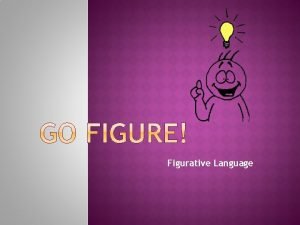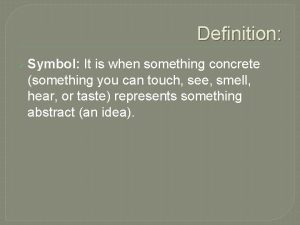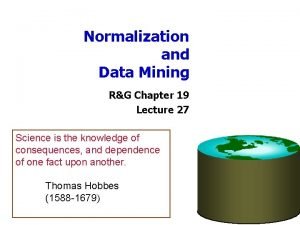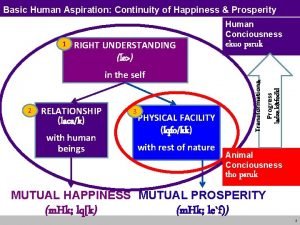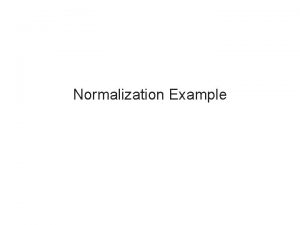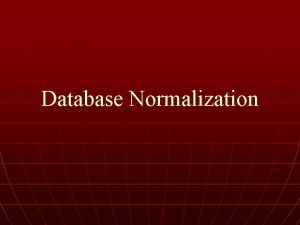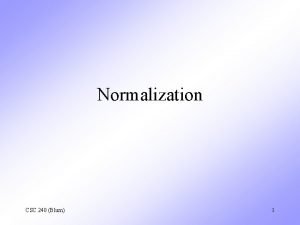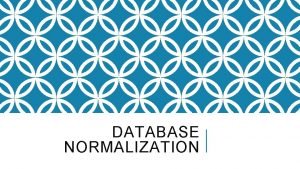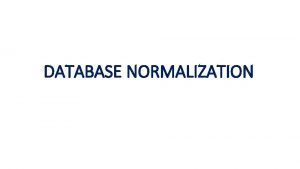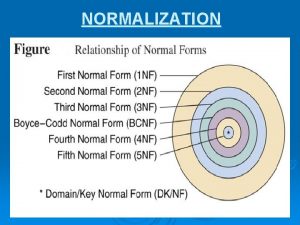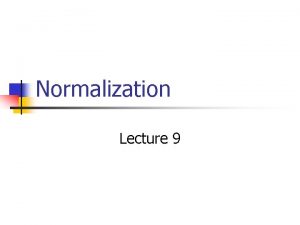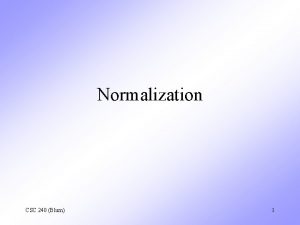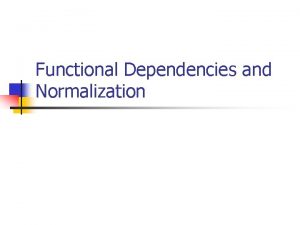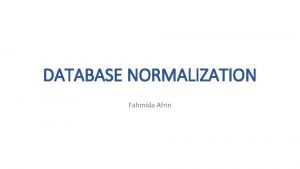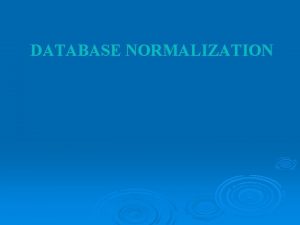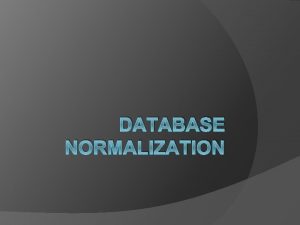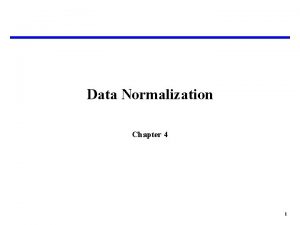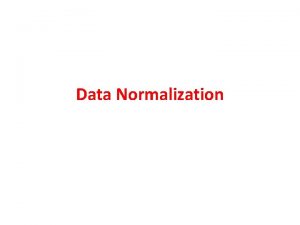Data Normalization Normal is not something to aspire


























- Slides: 26

Data Normalization Normal is not something to aspire to, it's something to get away from. ~ Jodie Foster ~

Activity: Sample User Report Can you build the underlying data model from this? How many tables? What are the relationships?

Understanding Functional Dependence l For attributes A and B, B is functionally dependent on A means each value in column A determines one and only one value in column B. ¡Written: A B ¡A determines B ¡B is the determinant ¡Ex: SSN Name (Name is functionally dependent on SSN)

Normalization Lingo l Prime attribute = Any attribute which is a primary key, or in the case of a composite key is part of a PK l Non-Prime Attribute = Any attribute which is not part of the PK. l Key Attribute = Prime Attribute l Non-Key Attribute = Non-Prime Attribute

Normalization and FD l Technically, normalization is just the analysis of Functional Dependencies of all columns with respect to the primary key. l There are three “levels” of analysis: 1. Functional Dependence – any non-prime attributes which as FD on the PK. 2. Partial Functional Dependence – any non-key attributes which are FD on part of the PK. 3. Transitive Functional Dependence – any non-key attributes which are FD on some other non-key attribute(s).

Activity: IYCDTYCN! Identify the: l Functional Dependencies (WRT the PK) l Primary Key? l Partial Functional Dependencies (WRT part of the PK) l Prime Attributes? l Non-Prime Attributes l Transitive Functional Dependencies (WRT some non-prime attribute)

The Dependency Diagram l The Dependency Diagram is a Very Useful Tool. It depicts the dependencies which exist among the attributes.

Normal Forms l A Normal Form represents the current “state” of the data model. l There are 4 basic normal forms: ¡ Zero Normal Form (0 NF) l Non-key attributes exist which are not FD on PK. ¡ First Normal Form (1 NF) l All non-key attributes FD on entire PK. ¡ Second Normal Form (2 NF) l In 1 NF and l No partial functional dependencies exist. ¡ Third Normal Form (3 NF) l In 2 NF and l No transitive functional dependencies exist.

First Normal Form (1 NF) l Definition: ¡ All non-key attributes must be FD on the entire PK. (There must be PKFD for all attributes. ) l Rule: ¡ Move each non-key FD column into its own new table. l How to Apply the Rule: For each non-key FD column: 1. Place non-FD column into a new table 2. Copy the PK (or part of it) from the original table into the new table. This will be a FK in the new table. 3. Assign a PK to the new table (typically a composite key of the original Non-FD column and the FK. )

1 NF: Example 1/2 l What’s wrong with this data model? ¡ What should be PK be? Why? ¡ Is there an attribute not FD on the PK? ¡ Is it in 1 NF already? ¡ What if Erin takes up bass fishing? ¡ I’m planning a ski trip, whom should I contact? l (How do I know Hobby 3, skiing and not Hobby 1)?

1 NF: Example 2/2 l What was done: ¡ Hobbies table created. Contains the originally non FD column, “hobby” ¡ The PK (FID) was copied into the hobbies table. ¡ The PK of the Hobbies table is the combination of FID and Hobby. l Questions: ¡ Is this in 1 NF? ¡ Can you reproduce the previous data model from this one? l Who likes skiing? Basketball?

Second Normal Form (2 NF) l Definition: ¡ The data model must be in 1 NF AND ¡ No partial functional dependencies can exist. l Rule: ¡ Move each partially FD non-key column into its own new table. l How to Apply the Rule: For each partial dependency: 1. Move all partially FD columns into a new table 2. Copy the determinant into the new table. 3. Make the determinant of the partial dependency: 1. The PK for the new table, FK to the existing table.

2 NF: Example 1/2 l What’s wrong with this data model? ¡ What should be PK be? Why? ¡ Do any partial dependencies exist? l Where? l What is the determinant for each, if any? ¡ Is it in 1 NF already? 2 NF? ¡ I made a mistake, 81 HLV 3 is a Power edge 5500, not a 4400?

2 NF: Example 2/2 l What was done: ¡ Serial Num + SWID is the primary key. ¡ Servers, Software tables created from partial dependencies, where Serial Num, SWID are the determinants. ¡ Serial Num, is the PK for Servers, SWID is the PK for Software, each are also FK’s for the SWInstallation table l Questions: ¡ Is this in 2 NF? ¡ Can you reproduce the previous data model from this one?

Third Normal Form (3 NF) l Definition: ¡ The data model must be in 2 NF AND ¡ No transitive functional dependencies can exist. l Rule: ¡ Move each transitive FD non-key column into its own new table. l How to Apply the Rule: For each transitive dependency: 1. Move all transitive FD columns into a new table. 2. Copy the determinant column into the new table. 3. Make the determinant of the transitive dependency: n The the PK for the new table. n The FK for the original table.

3 NF: Example 1/2 l What’s wrong with this data model? ¡ What should be PK be? Why? ¡ Do any transitive dependencies exist? l Where? l What is the determinant for each, if any? ¡ Is it in 1 NF already? 2 NF? 3 NF? ¡ I made a mistake, Koors phone number is 4905? l What’s wrong?

3 NF: Example 2/2 l What was done: ¡ Beer ID is the PK. ¡ All transitive dependencies moved into a new table, Distributors. ¡ Distrib ID is the determinant. PK of Distributors table, FK in original Beer table. l Questions: ¡ Is this in 3 NF? ¡ Can you reproduce the previous data model from this one?

Higher Normal Forms Yes, there IS more… … and it will blow your mind.

Boyce-Codd Normal Form (BCNF) l Rule: Eliminate key-transitive dependencies l A table in BCNF Means: ¡The table is in 3 NF ¡It includes no Non-Key attribute which determines a key attribute, or part of a key attribute.

BCNF: An Example

Fourth Normal Form (4 NF) l RULE: Eliminate multiple sets of multivalued dependencies. l A table in 4 NF Means: ¡The table is in 3 NF ¡It includes no sets of attributes which contain multi-valued dependencies.

4 NF: An Example Figure 4. 15 Set of Tables in 4 NF Figure 4. 14 Multivalued Dependencies

How “far” should one Normalize? l For relational databases: ¡ 1 NF is required, at minimum for practical RDBMS implementations. ¡ The majority of the time data models are normalized to 3 NF. ¡ Sometimes certain tables are left in 1 NF or 2 NF, for performance or practical reasons. ¡ Higher normal forms BCNF, 4 NF are rare. l In General, the Higher the NF of your DM: ¡ The more complicated the internal DM ¡ The more “programming” required to reproduce the external DM. ¡ But, the lesser the chance for data anomalies!! l It’s a total trade-off: ¡ Database complexity vs. data anomalies.

Mike’s “Road To 3 NF” To normalize correctly, follow this process for each table in the data model: Designate a candidate key Any partial dependencies? PKFD for all attributes? n Apply 1 NF Rule y 1 NF y Apply 2 NF Rule n Party Hard ! 2 NF Any transitive dependencies? y Apply 3 NF Rule n 3 NF

Normalization Summary Cheat Sheet l 0 NF O l 1 NF O l 2 NF O 1 NF O (Resolve non FD) N 2 NF (Resolve Partial FD) N 1 O N 2 3 NF (Resolve Transitive FD) O N

Data Normalization Questions?
 Smart is something you become not something you are
Smart is something you become not something you are Aspire not to
Aspire not to A part of something abstract
A part of something abstract Explanation purpose
Explanation purpose Literal vs figurative language worksheet
Literal vs figurative language worksheet What does concrete symbolize
What does concrete symbolize Symbol/symbolism definition
Symbol/symbolism definition Something old something new poem
Something old something new poem Something that describes something
Something that describes something Data transformation by normalization
Data transformation by normalization Data transformation by normalization
Data transformation by normalization 3 weeks from today
3 weeks from today Microarray
Microarray Sadlier vocabulary workshop level d unit 1 synonyms
Sadlier vocabulary workshop level d unit 1 synonyms Iechs aspire
Iechs aspire Aspire lunch menu
Aspire lunch menu The aspire test helps to measure and career readiness
The aspire test helps to measure and career readiness What is a good act aspire score
What is a good act aspire score Www.actaspire.org
Www.actaspire.org Act aspire student sandbox
Act aspire student sandbox Aspire together
Aspire together Aspire certification
Aspire certification As a student leader i aspire
As a student leader i aspire Noun form of aspire
Noun form of aspire Aspire as
Aspire as Aspire antonym
Aspire antonym What is basic human aspiration
What is basic human aspiration




